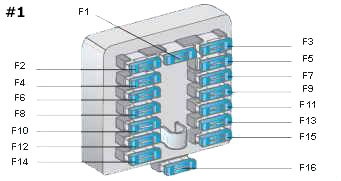Advertisements
Fuse box diagram (fuse layout), location, and assignment of fuses Peugeot 106 (1996, 1997, 1998, 1999, 2000, 2001, 2002, 2003).

Checking and Replacing Fuses
Your vehicle’s electrical system is protected from overloading by fuses. If any lights, accessories, or controls in the vehicle do not work, inspect the appropriate circuit protector. If a fuse has blown, the inside element will be melted.
Before changing a fuse, it is necessary to:
- Immobilise the vehicle and switch off the ignition,
- Switch off all electrical consumers,
- Identify the failed fuse using the fuse allocation tables and diagrams in the following pages,
- Identify and correct the cause of the problem.
When replacing a fuse, you must always:
- Use the special tweezer to extract the fuse from its holder and check the condition of its element,
- Replace a failed fuse by one of the same rating (same colour); the use of a different rating fuse could cause a fault (risk of fire).
- If the same fuse blows again, avoid using that system and have the vehicle’s electrical system checked by PEUGEOT dealer or a qualified workshop as soon as possible.
Notice
- Never use a fuse of a higher or lower amperage rating than that specified. This could damage the electrical system or cause a fire.
- Never replace a broken fuse with anything other than a new fuse (such as wire, foil, etc). Use always an intact fuse of the same color.
- Your vehicle’s electrical system is designed to operate with standard or optional equipment. Before installing other electrical equipment or accessories on your vehicle, contact a PEUGEOT dealer or a qualified workshop.
Passenger Compartment Fuse Box
The fuse panel is located behind the cover to the left of the steering wheel. To gain access, press the lug on the upper section and pull the flap towards you.


| № | A | Functions |
|---|---|---|
| 1 | - | Not used |
| 2 | 25 | Heater blower |
| 3 | 25 | Heated rear screen – air conditioning – pressure switch – heated seats |
| 4 | 25 | Radio – map reading light |
| 5 | 30 | Heated rear screen - horn - lighter + heated mirrors |
| 6 | 10 | Direction indicators / hazard warning lights |
| 7 | 10 | Engine cooling – electronic immobiliser – coolant temperature control unit – instrumentpanel – power steering – reversing lights |
| 8 | 20 | Central locking - electronic immobiliser – interior lighting – boot lighting -coolant temperature control unit - instrument panel - radio - clock |
| 9 | 30 | Electric windows - hazard warning lights - electric mirrors – brake lights – front and rearwipers - instrument pane |
| 10 | 20 | Front electric windows |
| 11 | 5 | Rear fog light + instrument panel lights |
| 12 | 5 | Left tail-light – front sidelights - instrument panel lighting (rheostat) + headlamp heightadjustment |
| 13 | 5 | Switch lighting – radio panel lighting – number plate lighting – right tail light |
Advertisements
Engine Compartment Fuse Boxes
There are two fuse boxes near the battery. To gain access to the fuses, unhook the covers.




| № | A | Functions |
|---|---|---|
| 1 | - | Not used |
| 2 | 30 | Anti-lock braking system |
| 3 | 25 | Engine cooling |
| 4 | 20 | Anti-lock braking system |
| 5 | 25 | Fan unit |
| 6 | 20 | Additional driving lamps |
| 7 | - | Not used |
| 8 | - | Not used |
| 9 | 10 | Fuel pump |
| 10 | - | Not used |
| 11 | 10 | Oxygen sensor |
| 12 | 10 | Left-hand main beam |
| 13 | 10 | Right-hand main beam |
| 14 | 10 | Left-hand dipped beam |
| 15 | 10 | Right-hand dipped beam |
| 16 | 30 | Pulsair pump |
| MF1 | 20 | Lighting switch |
| MF2 | 80 | Ignition supply (starter +ve) |
| MF3 | 40 | Ignition supply (ignition controlled +ve) |
| MF4 | 40 | Battery +ve feed to 13-fuse box |
Advertisements
